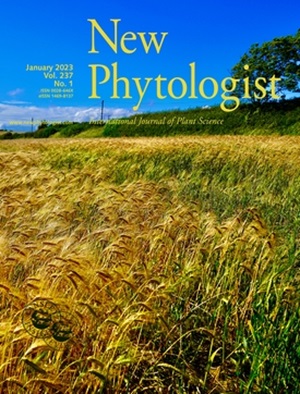MtNAD1 associates with the autophagy complex to contribute to the degradation of immunity-related proteins in Medicago truncatula nodules
IF 8.3
1区 生物学
Q1 PLANT SCIENCES
引用次数: 0
Abstract
- Plant immunity is suppressed in the symbiotic nodule cells, thereby facilitating rhizobial infection. Medicago truncatula NODULES WITH ACTIVATED DEFENSE1 (MtNAD1) is crucial for suppressing immunity in nodules; however, its molecular function is unclear.
- We explored the molecular basis of the role of MtNAD1 in suppressing innate immunity in M. truncatula nodules.
- Medicago truncatula mutants lacking MtATG7 produced defective nodules, sharing some similarities with the Mtnad1 mutant nodules. Furthermore, MtNAD1 interacted with several immunity-related proteins, including BAX-inhibitor1a (MtBI-1a), two Lysin-motif proteins (MtLYM1/2), Pathogenesis-related10 (MtPR10c/d), MtMPK3/6, and two Lysin-motif receptor kinases (MtLYK8/9). In addition, MtNAD1 and the autophagy pathway contributed to the reduction of MtBI-1, MtPR10c/d, and MtLYM1/2 protein levels in planta. Knocking out either the MtBI-1 or MtLYM1/2 gene in the M. truncatula nad1 mutant can partially restore the defective nodules of the nad1 mutant.
- Our results demonstrate that MtNAD1 associates with the autophagy pathway by interacting with MtATG8, contributing to the degradation of several immunity-related proteins in M. truncatula nodules during rhizobial colonization and thereby supporting the development of a successful symbiosis.
求助全文
约1分钟内获得全文
求助全文
来源期刊

New Phytologist
生物-植物科学
自引率
5.30%
发文量
728
期刊介绍:
New Phytologist is an international electronic journal published 24 times a year. It is owned by the New Phytologist Foundation, a non-profit-making charitable organization dedicated to promoting plant science. The journal publishes excellent, novel, rigorous, and timely research and scholarship in plant science and its applications. The articles cover topics in five sections: Physiology & Development, Environment, Interaction, Evolution, and Transformative Plant Biotechnology. These sections encompass intracellular processes, global environmental change, and encourage cross-disciplinary approaches. The journal recognizes the use of techniques from molecular and cell biology, functional genomics, modeling, and system-based approaches in plant science. Abstracting and Indexing Information for New Phytologist includes Academic Search, AgBiotech News & Information, Agroforestry Abstracts, Biochemistry & Biophysics Citation Index, Botanical Pesticides, CAB Abstracts®, Environment Index, Global Health, and Plant Breeding Abstracts, and others.
 求助内容:
求助内容: 应助结果提醒方式:
应助结果提醒方式:


